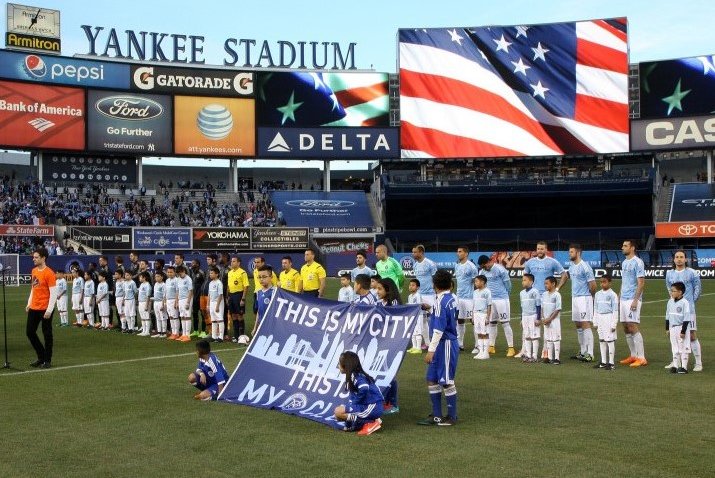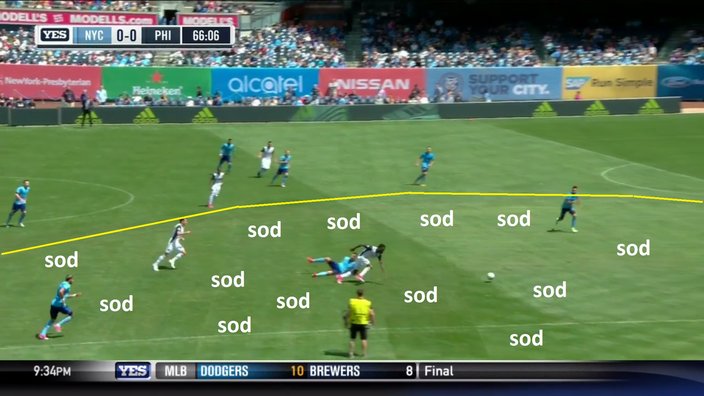
June 06, 2017
 Paul Rudderow/Philly Soccer Page
Paul Rudderow/Philly Soccer Page
New York City FC has been playing home games at Yankee Stadium since joining Major League Soccer in 2015.
Last year, a member of the Philadelphia Union coaching staff told PhillyVoice that the soccer field at Yankee Stadium was shaped "like a rhombus."
If you don't recall grade school geometry, a rhombus is a four-sided parallelogram, kind of like a crooked rectangle resembling a kite. The lines are equal length but they're not straight.
Toronto FC head coach Greg Vanney suggested something similar in March, and Sporting Kansas City manager Peter Vermes even stated that New York City's pitch is not regulation size.
“It’s 68 by 106,” Vermes told FourFourTwo Magazine a few months back.
FIFA mandates that the minimum size for soccer fields is 110 yards by 70 yards, which is what New York City claims are the specs for their home field. Talen Energy Stadium, for context, is 120 by 75.
But even if Yankee Stadium does contain a properly sized field, it barely passes regulations, resulting in dumb sequences like this one from Saturday afternoon where the ball touches the ground just three times in 26 seconds.
Size is one thing, but the bigger issue is the constant reconditioning of the pitch in the area that doubles as the Yankees' infield. Crews work throughout the summer to lay grass over the dirt, resulting in one quadrant of the field playing at a different consistency than the undisturbed grass outfield.
The field is positioned so that workers don't have to remove and rebuild the pitcher's mound every single week.
For an experiment, I logged every single time that a player lost their footing on Saturday afternoon.
4:56 – Oguchi Onyewu
4:57 – Warren Creavalle
5:43 – Ethan White
5:55 – Haris Medunjanin
8:38 – Haris Medunjanin
13:51 - Jack Elliott
17:10 – Miguel Camargo
21:47 – Fafa Picault
31:46 – Tommy McNamara
41:52 – Haris Medunjanin
45 + 1' – David Villa
45 + 1' – Jack Harrison
45 + 3' – Tommy McNamara
45:28 – Alex Ring
46:15 – Ben Sweat
47:42 – C.J. Sapong
49:17 – Haris Medunjanin
50:17 – Richie Marquez
52:15 – Alexander Callens
66:04 – Ben Sweat
66:06 – Ben Sweat
74:54 – Fafa Picault
83:29 – Ray Gaddis
88:50 – C.J. Sapong
That's 24 slips in 90 minutes – or one per every 3.75 minutes.
This one was particularly telling, with Oguchi Onyewu losing his footing, then taking a glance at the ground. Warren Creavalle, dropping in defensively, then falls about two seconds later.
Sixteen of 26 field players fell at least once on Saturday, and half of those players were from the home team, which suggests to me that NYC isn't even really getting any kind of advantage from playing on the familiarly crappy surface.
In this clip, they forfeit a set piece opportunity when Miguel Camargo winds up on his rear end.
That slip actually happened on the good part of the field.
Eighty percent of the issues I logged took place in the sodded quadrant, which you can see below. I picked a screen grab from the 66th minute, where New York left back Ben Sweat fell twice in three seconds, forcing Alex Callens to shift wide and poke the ball out of play.
That context is also important to consider; left backs have a harder time at Yankee Stadium than right backs.
Each left fullback will have to defend on that sod for 45 minutes. Right fullbacks don't have to defend on it at all, but will spend the other 45 minutes attacking that area of the field. That was an advantage for Ray Gaddis and Ethan White, while Fabinho and Sweat had to deal with more difficult circumstances.
Here's the thing, however: when Manchester City and the New York Yankees say they want to be a part of Major League Soccer, you don't say no.
As sad as Yankee Stadium is, the addition of a second New York team brought David Villa, Patrick Vieira, Andre Pirlo, and Frank Lampard to MLS. It gave us another high-spending club, another franchise willing to push the envelope and bolster our "domestic" product.
No, they didn't have a field to play on, but this was a sacrifice that had to be made. Plus, we've still got teams playing on NFL fields in 2017, and RFK Stadium is still in use for a few more months. This isn't the only stadium issue in Major League Soccer.
For now, it's just something we're going to have to live with.
